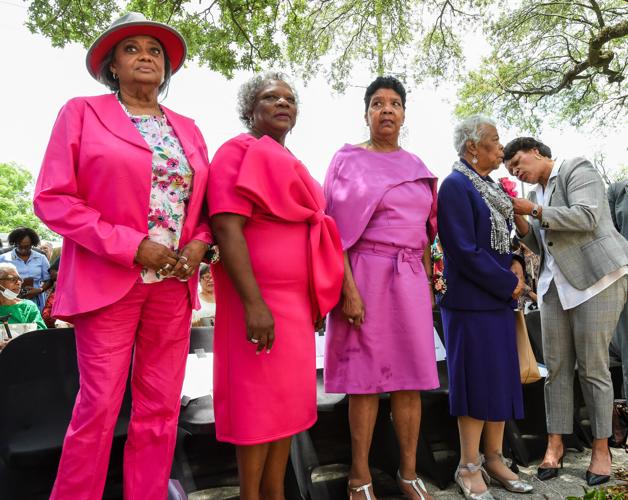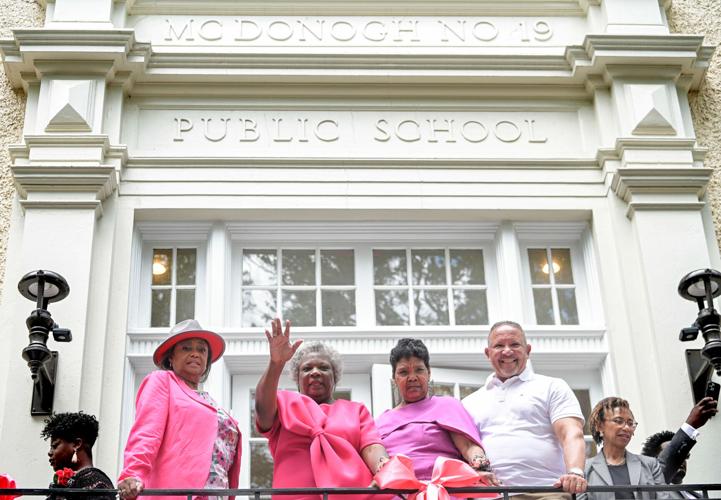Surrounded by ugly racist chants, four 6-year-old Black girls began the painstaking and frightening process of integrating New Orleans’ public schools in 1960. This historic moment is the focal point of an upcoming three-part docuseries, “The New Orleans Four Legacy,” by filmmaker Diedra Meredith.
Most Americans are familiar with Ruby Bridges, the lone Black child who walked into William Frantz Elementary School in New Orleans on Nov. 14, 1960, to hateful jeers. But just blocks away, three other little girls walked into McDonogh 19 on the same day, also part of the effort to integrate public schools under the Brown vs. Board of Education decree of 1954.
In Brown, the U.S. Supreme Court ruled that the “separate but equal” policy that had existed throughout the Deep South, was unconstitutional and violated the 14th Amendment, which provides equal protection under the law to all U.S. citizens.
Leona Tate, one of the three girls at McDonogh 19, accompanied by Gail Etienne and Tessie Prevost, thought it was time to tell the real story of The New Orleans Four. In 2017, Meredith’s mother, a friend of Leona Tate, suggested to her daughter that she contact Leona about her endeavor to purchase the McDonogh 19 Elementary School building and turn it into a Civil Rights Interpretive Center. Meredith thought she could help her by creating the New Orleans Four Legacy Project, to tell the unvarnished truth about the New Orleans school desegration crisis of 1960, and the New Orleans resistance movement.

“It was her vision to promote the New Orleans Four, three of whom had been forgotten,” Meredith explained. “She was using a shotgun house at the time to display an exhibit, detailing the struggles of integration. It’s now part of the TEP Interpretive Center, the educational facility now housed in the former McDonogh 19 school building, which Tate integrated as a child, and eventually arranged to buy."
TEP is an acronym for the last name initials of Tate, Etienne and Prevost.
Site placed on historic registry
Through the Leona Tate Foundation for Change, Tate arranged to buy her former school in a partnership with the city and the Housing Authority of New Orleans. The third and fourth floors were designated as affordable housing for seniors. The state offered historic tax credits, and the site was finally designated on the historic registry, thanks to the Plessy & Ferguson Foundation.
The Meredith docuseries is planned as a chronicle in three parts, the first two detailing the history of the Civil Rights Movement and its many living legends. Part 3 will be finished once Meredith reaches her goal of getting 1.4 million signatures on a petition to make “New Orleans Four Day” (now recognized in New Orleans on Nov. 14) a national day of celebration.
Although parts 1 and 2 have not been shown publicly yet, the screener is chock full of New Orleans notables and is introduced by Marc Morial, former mayor and now president of the National Urban League.
The series tells the story of that unforgettable day in 1960 when teachers were mandated to stay at McDonogh 19, as every White child was pulled out by their parents, leaving three girls alone and bewildered in a classroom that morning — and for the rest of the year.
In short order, White parents pulled their children out of McDonogh 19 permanently, and within two years the school was entirely Black.
“So, in the third grade, the same three girls were sent to integrate the T.J. Semmes Elementary School, but this time parents didn’t take their White children out of the school,” Meredith said.
Harassment and lies
The girls were horribly harassed. Etienne was hit in the stomach with a baseball bat, and even endured her dress being ripped off by angry students.
"Segregationist teachers were telling the older kids to harass the girls," Meredith said. "U.S. marshals should have accompanied the girls again, but then-Gov. Jimmy Davis lied to (President John F. Kennedy), and told him the situation didn’t call for this sort of intervention.”

Filmmaker Diedra Meredith (Photo by Peter G. Forest)
For Meredith, a New Orleans native, an alumna of St. Mary’s Academy and an LSU graduate, this project is personal.
In the interest of authenticity, Meredith struck an agreement with the Historic New Orleans Collection to use its extensive archival footage and stills of the Civil Rights Movement.
A 2020 event at Gallier Hall honored the New Orleans Four on the 60th anniversary of school integration in the state, but Meredith wants the nation to know about the sacrifices the other girls made as well, through The New Orleans Four Legacy Project.
“I simply want to recognize those that were responsible for changing the trajectory of school integration and undo the illegitimate revisionist history about the New Orleans desegregation crisis,” Meredith said. “We’re making headway."
A freedom ride from New Orleans to Washington, D.C., is planned once the petition is complete.
"It will be the climactic finish to Part 3 of the docuseries and will set the record straight,” Meredith said.





